Marketing is an essential function of any company, whether your potential customers are individuals or other businesses.
But business-to-business (B2B) giants like Salesforce, Microsoft, and Oracle know that marketing to other businesses is a complex endeavor, possibly involving multiple decision-makers and layers of approval.
But at the end of the day, B2B marketers still work with humans, not nebulous business entities, so the core principles of marketing hold true.
What is B2B marketing?
B2B marketing, short for “business-to-business marketing,” refers to marketing products or services to other businesses rather than to individual consumers.
Marketing to the end consumer is known as B2C (business to consumer) marketing, and B2C brands include companies like Walmart, Starbucks, or Apple. This distinct target market affects every aspect of a B2B company’s marketing plan—from the initial brand strategy to the lengthy sales cycle.
Within the umbrella category of B2B marketing, there are two approaches: lead-based marketing and account-based marketing.
Lead-based marketing
Lead-based marketing is a broad approach to attracting more business customers, where messaging is geared toward a wide audience. It doesn’t matter whether or not they’re part of a B2B company’s target audience.
The lead-based marketing funnel has a very wide top—meaning this approach aims to capture as many leads as possible, no matter how qualified they are as customers. As this large number of leads move down the funnel, only a small percentage may make it through to the bottom of the funnel and convert into paying customers.
Account-based marketing
Account-based marketing is a tailored approach to high-value B2B customers, where each customer is treated as its own market. Lead-based marketing is a one-size-fits-all approach, whereas account-based B2B marketing is relationship-based.
Each account and buyer’s journey is unique. A B2B company pursuing an account-based marketing tactic targets specific businesses that it wants to turn into customers and pursues them with tailored strategies.
In this way, its funnel has a narrower top, as potential customers are theoretically already closer to conversion than those coming through a lead-based approach.
B2B vs. B2C marketing: What’s the difference?
The primary difference between B2B and B2C marketing is the audience: B2B sells to businesses, while B2C sells to individual consumers.
Marketing fundamentals remain constant across B2B and B2C marketing, but the specific strategies and tactics differ because the audience is different. The key differences include:
- Decision-makers. Generally speaking, in B2C, one individual makes purchase decisions. In B2B, there often are many people involved in decision-making. Purchase decisions have to be sent up the management chain for approval and may require team input. The effort involved in deciding to purchase a new software for your sales team is generally greater than what’s involved in the decision to buy new eyeglasses.
- Sales cycle. Because there’s only one decision-maker involved, the B2C sales cycle can be quite short. Of course, there is some length variance—which often correlates to the price point of the marketed item. The B2B sales cycle is longer, as it normally requires layers of input and approval.
- Brand strategy. B2C branding often speaks to customer emotions. B2B branding, by contrast, appeals to customers’ intellect, using data and formal case studies to show how the product or service is the reliable solution to a real or perceived pain point.
How to create a B2B marketing plan
No one-size-fits-all marketing plan guarantees success for every B2B company. Still, the basics of creating a marketing plan are broadly applicable to most B2B companies.
1. Determine brand positioning
Brand positioning helps your product and brand stand out from the competition. Think about what problem your product or service is solving and what makes it unique—in other words, which pain points it addresses and what makes it different from other solutions.
This might mean focusing on your superior quality, excellent customer service, ease of implementation, or competitive pricing. You may develop multiple versions of your positioning if your product has many use cases.
2. Define target audience
Your target audience is your ideal customer. Many attributes could define them: industry, company size, locations where they do business, annual revenue, and years in operation. Your target audience likely has a problem your product or service can solve or a need it can meet.
3. Develop channel strategies
Once you know your target audience, you must figure out how and where to reach them. This is where marketing channels come in.
Marketing channels are ways of distributing content. They include:
Social media
LinkedIn is often the most-used social media platform for B2B marketers since it’s a work-focused social network. But B2B marketers may also tap into Instagram, Facebook, Twitter, and other social media networks to reach their audiences.
Social media is both an organic channel (meaning you don’t have to pay to use it) and a paid channel (meaning you can distribute relevant content beyond your follower base).
B2B marketers can use email to circulate content and messaging to those who have shared their email with the business. You might initially touch base with a welcome email for new subscribers, follow up with webinar invitations, or share new blog posts.
Paid advertising
B2B marketers can buy advertising on search engines or display ads on websites relevant to their audiences. For example, a New York City–based digital ad agency could pay for its website to be the #1 result when someone searches “digital ad agencies NYC.”
Blog
A blog is a channel that doesn’t necessarily do the work of distributing content—but it is a hub of content that a marketer can send potential customers to. You can publish everything from SEO-driven content to widen the top of your funnel to product comparisons (you versus the competition) to close a purchase.
4. Leverage B2B marketing tools
Shopify B2B
If you’re in the B2B ecommerce space, there’s no better tool to reach more customers and drive more sales than Shopify. With Shopify’s B2B features, you can create a website that combines both your B2B and DTC (direct to consumer) operations. Flexible, all-in-one platforms like Shopify let you meet the omnichannel demands of today’s customers, while streamlining internal processes and guaranteeing a single point of truth.

The ability to provide a customizable buying experience for B2B customers is why Brooklinen brought its wholesale business to Shopify. Previously, its team had a highly manual sales process that depended on phone and email orders. With B2B on Shopify, Brooklinen added a second store just for B2B buyers. This store had all the same branding as its DTC counterpart, but with added functions like wholesale prices and exclusive products.
“On Shopify, our team has the liberty and the space to build relationships with customers, instead of
just transacting with them,” says Nicolas Lukac, director of emerging channels at Brooklinen. “We spend more time understanding our customers and less on manual inputs. This allows us to provide exceptional experiences for our DTC, B2B customers, and retail customers alike.”
Read: Brooklinen scales their wholesale business to new heights with B2B on Shopify
Semrush
Semrush is an all-in-one platform that helps improve your online visibility and marketing performance. More than 10 million marketing professionals use Semrush, and the platform is a go-to tool for 30% of Fortune 500 companies.

With a Semrush account, you get access to tools that help with:
- Search engine optimization (SEO)
- Competitor research
- PPC advertising
- Content marketing
- Market and keyword research
Semrush also offers awesome tools like Site Audit, which analyzes the health of your website for issues that impact your search rankings, and Market Explorer, which unveils your competitors’ marketing strategies. You can access most Semrush features with a free account, but to get access to more in-depth tools, paid plans start at $129.95 per month.
Hunter
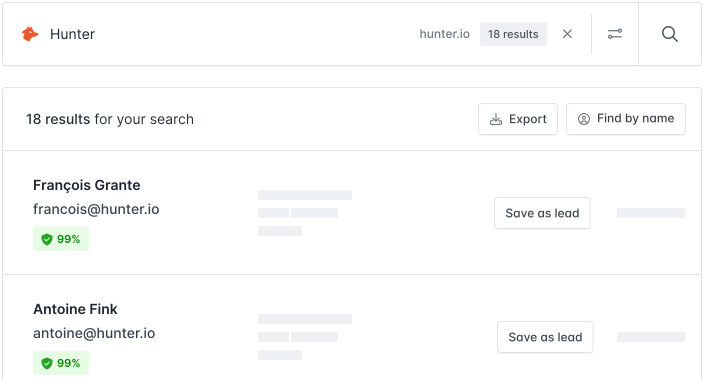
If you want to build a pipeline for outreach, Hunter is the perfect tool. Give Hunter a domain or company you want to pitch and the tool will find the best person to contact. You can also verify email addresses to avoid bounces and get contact details, such as name, position, and social media handles.
Google Analytics
Google Analytics (GA) should be in every B2B marketer’s toolkit. It tells you everything about how people find and interact with your website, so you can make improvements to the user experience. You can see what pages people visit, the actions they take, and even which devices they are using. This helps you assess website performance, understand if your market strategy is working, and identify pages to optimize and increase conversions on.
5. Create content pieces and assets
Forty-two percent of B2B buyers say they typically consume three to five pieces of content before communicating with sales. For many prospective buyers, these assets are their first meaningful interaction with your brand. The way to stand out is to ensure you’re offering something genuinely valuable.
Common content formats include the following:
- Blog posts. Blog posts are articles you publish. These can be of varying length and tackle topics related to your business. Executives might author thought leadership blogs to communicate big ideas or share how your brand sees the future. Your product marketing team might author blog posts about recently released features.
- Gated content. Gated content requires potential buyers to fill out a form before accessing it. Because customers are providing you with something valuable, such as their contact information, industry, or job title, the content they unlock should be very valuable to them—something above and beyond what’s available on your blog, like a white paper or ebook. Once someone gives you their information, you can use marketing automation to send them a series of emails to nurture the customer relationship.
- Videos and podcasts. Videos and podcasts can help you reach people who might prefer to watch or listen to content rather than read it. These multimedia formats can help nurture relationships with potential customers and move them further along the buyer’s journey.
- Webinars. Webinars—live video events—can function like gated content, as participants often are required to give their email address.
6. Execute campaign
A campaign is a marketing initiative focused on a central key idea. A typical campaign might begin with the publication of some marquis content like a white paper, which you promote on your social channels, through automated email marketing, and with paid ads.
To account for the longer selling cycle of B2B transactions, a campaign of this nature might run from six to nine weeks, and you would prioritize the social channels that your target audience research indicated were most important to your ideal buyer.
For something more involved, like a webinar, you might promote it on social, email, and paid ads for two weeks before the event date, then ramp up email and social the day of the event, and follow up periodically with email content targeted to attendees for the next several days or weeks.
7. Measure and improve
Once your content is live in the wild, you’ll monitor its performance metrics and decide how to maximize its reach. Is your ad creative on LinkedIn not driving the amount of traffic you expected? You might adjust the creative and see if it improves performance.
Some important B2B metrics to track include:
Cost per lead
Qualified sales leads are the goal of all B2B marketers, but your budget isn’t limited. Cost per lead measures how much money you spend to acquire a potential customer, which determines how effective your campaigns are.
Lead-to-conversion ratio
Also known as your sales conversion rate, the lead-to-conversion ratio measures the number of qualified B2B leads that become customers. It’s an important indicator of your sales funnel and is calculated on a monthly or weekly basis.
Return on marketing investment (ROMI)
ROMI measures how much revenue is generated for every dollar spent on marketing. This KPI is tracked over weeks or months because it takes time to close a B2B lead. ROMI can show how well your marketing contributes to your bottom line and justify marketing spend (and let you ask for more budget next quarter).
B2B digital marketing tactics
B2B content marketing
Content marketing is an internet marketing tactic that involves creating and distributing educational content that is relevant and valuable to your target audience. According to a Semrush survey, respondents cited creating and posting more content (52%) and improving content (51%) as the top tactics for gaining more organic traffic to their sites.
Content comes in many forms, such as product tutorials, in-depth guides, infographics, and checklists. It aims to drive customers to your website or online store and ultimately convert them into paying customers.
B2B search engine optimization
SEO is a digital marketing tactic that involves optimizing your website and online content to get higher rankings in search engine results pages (SERPs). Forty-five percent of B2B companies plan on increasing their content marketing spend within the next 12 months.
The goal of SEO is to drive more traffic to your website from SERPs, which should ultimately lead to more business buyers and revenue—like how Clothing Supplier shows up in the number 2 position on Google when searching for “wholesale clothing suppliers”:
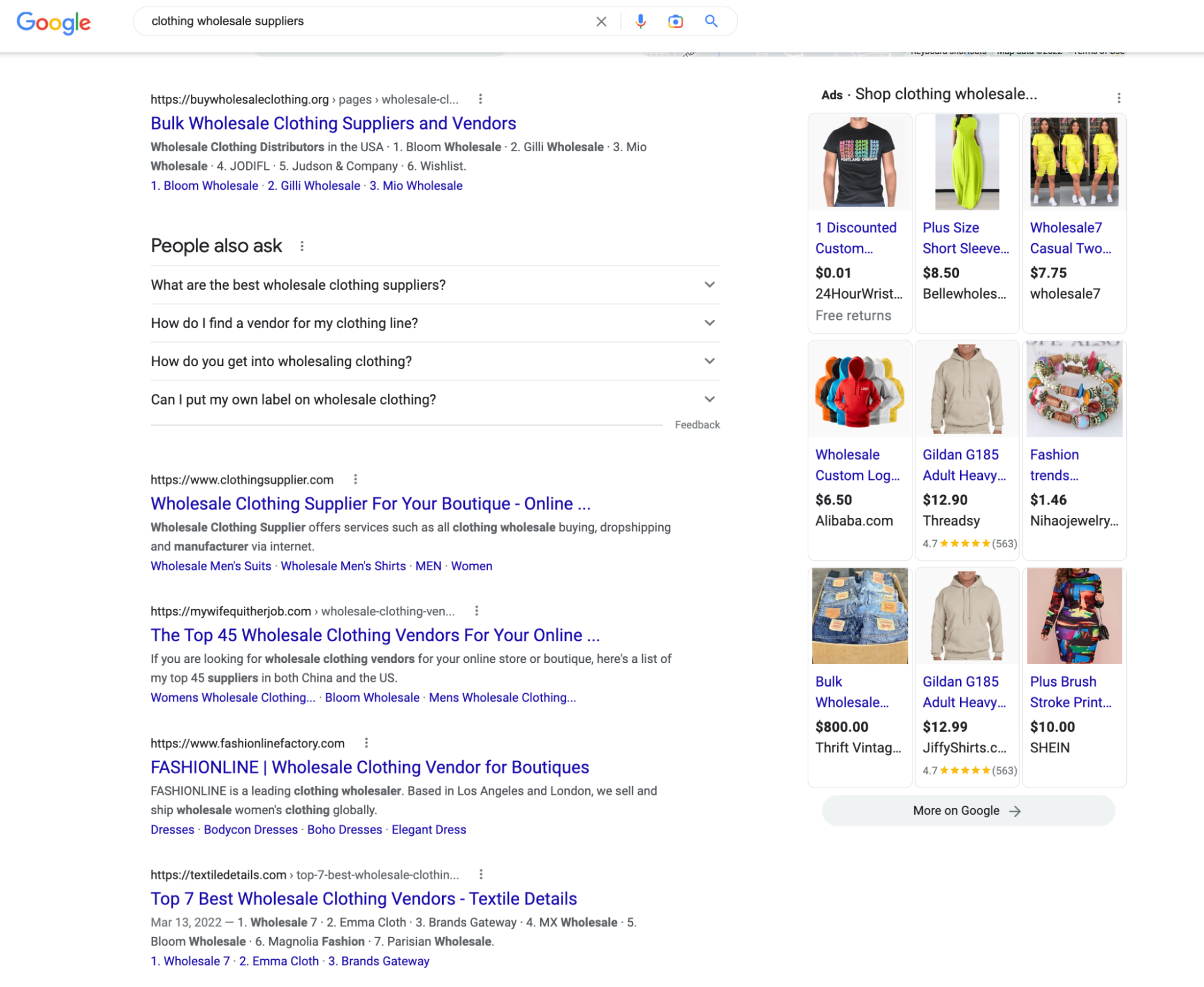
B2B social media marketing
SMM is a digital marketing tactic that uses social media platforms to promote your products or services. SMM aims to reach more potential customers and followers and build authority in a particular niche. B2B brands today use social media channels like LinkedIn, Instagram, Facebook, and even TikTok to market their brands online.
B2B testimonials and case studies
Testimonials and case studies are powerful tools B2B marketers can use to build relationships with their target audiences.
By featuring customer success stories, B2B marketers can showcase the value of their products or services, which can help build trust and credibility with potential customers. They can provide potential customers with a better understanding of how their products or services can be used to solve specific problems.
By using testimonials and case studies, B2B marketers can position themselves as trusted experts in their field and earn leads.
B2B lead generation
B2B marketers can benefit from lead generation in many ways. It can help them keep their sales pipeline full, identify potential customers, and create a list of potential customers. Lead generation can also help B2B marketers establish their brand in the marketplace and increase brand awareness.
B2B referral
Referral marketing involves using your satisfied customers to generate your company’s new B2B business leads. A referral program can help B2B marketers reach new customers they wouldn’t otherwise be able to reach. Besides that, referral marketing can help build trust and credibility for a brand.
B2B email
With email marketing, B2B marketers can target buyers with specific and personalized messages. By segmenting their email list, B2B marketers can send targeted messages to buyers who are most likely to buy.
For example, Typeform sends free users product updates and templates they can use in the platform. This encourages people to use Typeform and improves product adoption:
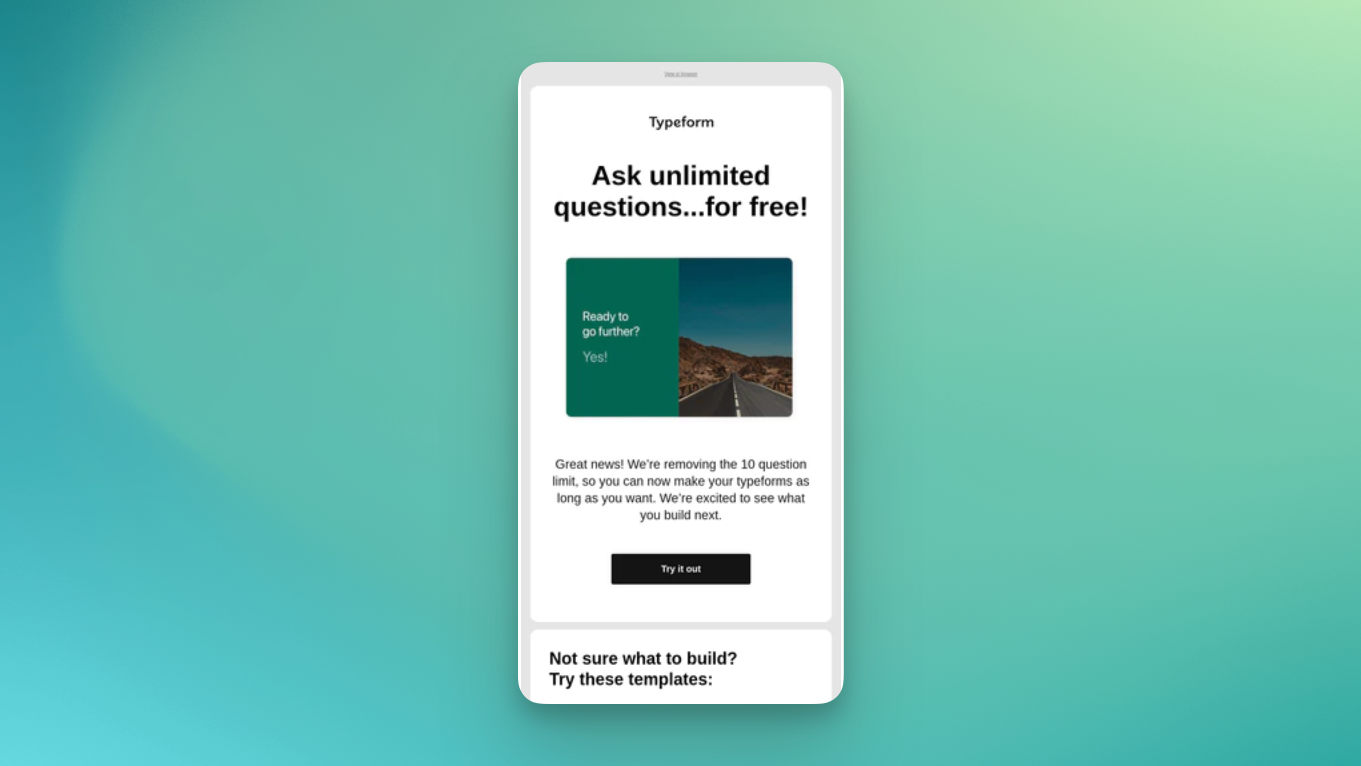
B2B paid advertising
A business can generate leads and reach potential customers with paid advertising. Targeted messaging can help promote brand awareness and reach a wider audience. You can use paid ads to retarget existing customers and promote special offers.
Google Ads, LinkedIn Ads, and Facebook Ads are the top ad channels for B2B marketers. It’s best to combine paid advertising with other marketing activities like content marketing, email marketing, and SEO.
B2B video
Video marketing is one of the most effective ways for B2B marketers to connect with their audience and promote their products or professional services. Videos can help build trust and credibility, convey key messages, and drive leads and sales.
Marketers make product demos and explainer videos to introduce their products or services to potential customers. They also use video testimonials and customer case studies to show how their products or services have helped other businesses.
B2B marketers who use video marketing see higher conversion rates, engagement, and brand awareness. Additionally, video marketing can generate and nurture leads through the sales funnel.
B2B podcasts
Podcasts are a great way to reach a new audience with your message. Creating a podcast allows you to tap into a new pool of potential customers and followers.
When you produce high-quality, informative, and entertaining content, your audience will begin to trust and respect your brand. As you build trust, you’ll also be able to generate more leads.
A well-executed podcast marketing campaign can do wonders for your brand awareness. As your podcast gains traction, more people will be exposed to your brand, resulting in more leads and customers.
B2B marketing best practices
Although B2B customers are companies rather than individuals, it’s important to remember:
- Through analytics and well-crafted marketing, B2B purchase decisions can be predicted, measured, and improved upon.
- Everything starts with your audience. Develop a deep understanding of their motivations, their pain points, and what they care about most. Document your findings as buyer personas so multiple departments can also learn about your target buyers.
- The decision to buy is a journey. Thoughtfully design each phase to keep potential customers engaged as they move through your marketing funnel. Give them the resources they need to pitch your product or service to stakeholders.
- Monitor performance and iterate until you find what really works. Invest more in the type of marketing that produces the best results.
- Invest in B2B marketing tools to help salespeople close deals. At minimum, you’ll want a CRM (customer relationship management), team collaboration tools, lead generation tools, and market intelligence tools to streamline the marketing process and close more deals.
Ultimately, decision-makers are still humans. Speak to them as such.
B2B marketing trends
The landscape of B2B marketing is always changing, and it can be hard to keep up with the latest trends. However, it’s important to stay up to date to stay ahead of the competition.
Here are five B2B marketing trends that will dominate in 2024:
The rise of account-based marketing
Account-based marketing is a strategic approach to B2B marketing that focuses on key accounts instead of broad segments. ABM has been on the rise recently, as more companies adopt it as their go-to digital marketing strategy.
Using ABM has many benefits, including improved ROI, better alignment between sales and marketing, and more targeted campaigns. However, there are a few challenges to using ABM, such as the need for more personalized content and the difficulty of measuring success.
Despite the challenges, ABM is still a very effective marketing strategy that will only become more popular in the coming years. If you’re considering adopting ABM for your business, now is the time to start planning and implementing your strategy.
The continued growth of content marketing
By 2026, content marketing will be a 487 billion industry. This growth is being driven by the continued rise of digital marketing and the increasing use of content marketing by businesses of all sizes.
B2B marketers who blog receive 67% more leads than those who do not. This is just one of the many benefits of blogging. Other benefits include improved SEO, increased website traffic, and higher conversion rates.
The most effective B2B content marketers have a documented content marketing strategy. This document should outline your goals, target audience, content topics, and distribution channels. Without a strategy, measuring your success and improving your content marketing efforts will be difficult.
The rise of video marketing
Video is becoming an increasingly popular format for marketing content. Many companies use video to reach new audiences and engage potential customers. Video is a great way to humanize your brand and build trust with your audience.
There are many different ways to use video in your marketing, from product demonstrations to customer testimonials. Video can be a powerful tool for driving leads and sales when used effectively.
Here are some tips for creating effective video content:
- Keep it short and sweet. People have short attention spans, so make sure your videos are less than two minutes long.
- Make it visually appealing. Use attractive visuals and graphics to keep viewers engaged.
- Use a strong call to action. Tell viewers what you want them to do after watching your video.
- Test different types of videos. Try different types of videos to see what works best for your business.
If you’re not yet using video in your marketing, now is the time to start. With the right strategy, video can be a powerful tool for driving leads and sales.
The power of personalization
The power of personalization should not be underestimated. To succeed with personalization, marketers must focus on creating relevant, targeted content that resonates with their audience.
Personalization can be used to create a more intimate connection with customers and prospects, which can lead to improved relationships and conversions.
Personalization is a powerful tool that can help marketers achieve their goals. Personalization can lead to increased website traffic, engagement, conversions, and customer satisfaction when used correctly. Focus on personalization if you want to improve your marketing results in 2024.
The rise of AI
As we move into 2024, it’s clear that AI is going to play a big role in the world of marketing, especially when it comes to B2B marketing.
Here are some ways AI will excel in the coming year:
- Targeting ideal customers precisely. By leveraging data and using AI-powered marketing technology, marketers can identify the specific characteristics of their ideal customer and target them with laser-like precision.
- Automating repetitive tasks. B2B marketers are using AI to automate repetitive tasks, like email marketing and lead generation. Doing so can free up their time to focus on more strategic tasks.
- Personalizing marketing messages and content. By understanding each customer’s specific needs and interests, AI can help marketers create highly relevant and personalized content.
- Generating insights from data. By analyzing large data sets, AI can help marketers identify patterns and trends they can use to make better decisions.
- Optimizing B2B marketing campaigns in real time. By constantly monitoring data and making adjustments, AI can help marketers ensure that their campaigns are as effective as possible.
These are just a few of the ways that AI is being used in the world of B2B marketing. As AI continues to evolve, we can expect to see even more innovative and effective uses for it in the coming years.
B2B marketing examples
DARCHE
DARCHE, an Australian outdoor and camping market leader since 1991, transformed its B2B marketing strategy by upgrading to Shopify, significantly improving its online store’s performance and user experience.
This shift enabled a streamlined wholesale ordering process, resulting in a three-times year-over-year increase in B2B sales anticipated for 2024, a 59% rise in annual web traffic, and surpassing 12 months’ worth of sales in just four months.
Shopify’s B2B features, such as company profiles, custom catalogs, personalized price lists, and self-serve purchasing, alongside integration with DARCHE’s ERP system, enhanced inventory management and provided a tailored experience for both B2B and DTC customers. These improvements have not only driven sales and web traffic but also positioned DARCHE to expand internationally,
👉Read: DARCHE drives wholesale revenue with B2B on Shopify
Semrush
B2B software brand Semrush promotes its products and services globally through Facebook Ads and Instagram ads. The ads vary. One may show off an infographic to a top funnel audience to help solve a problem. Or, you might find a video in your feed containing a horror story about ad spend.
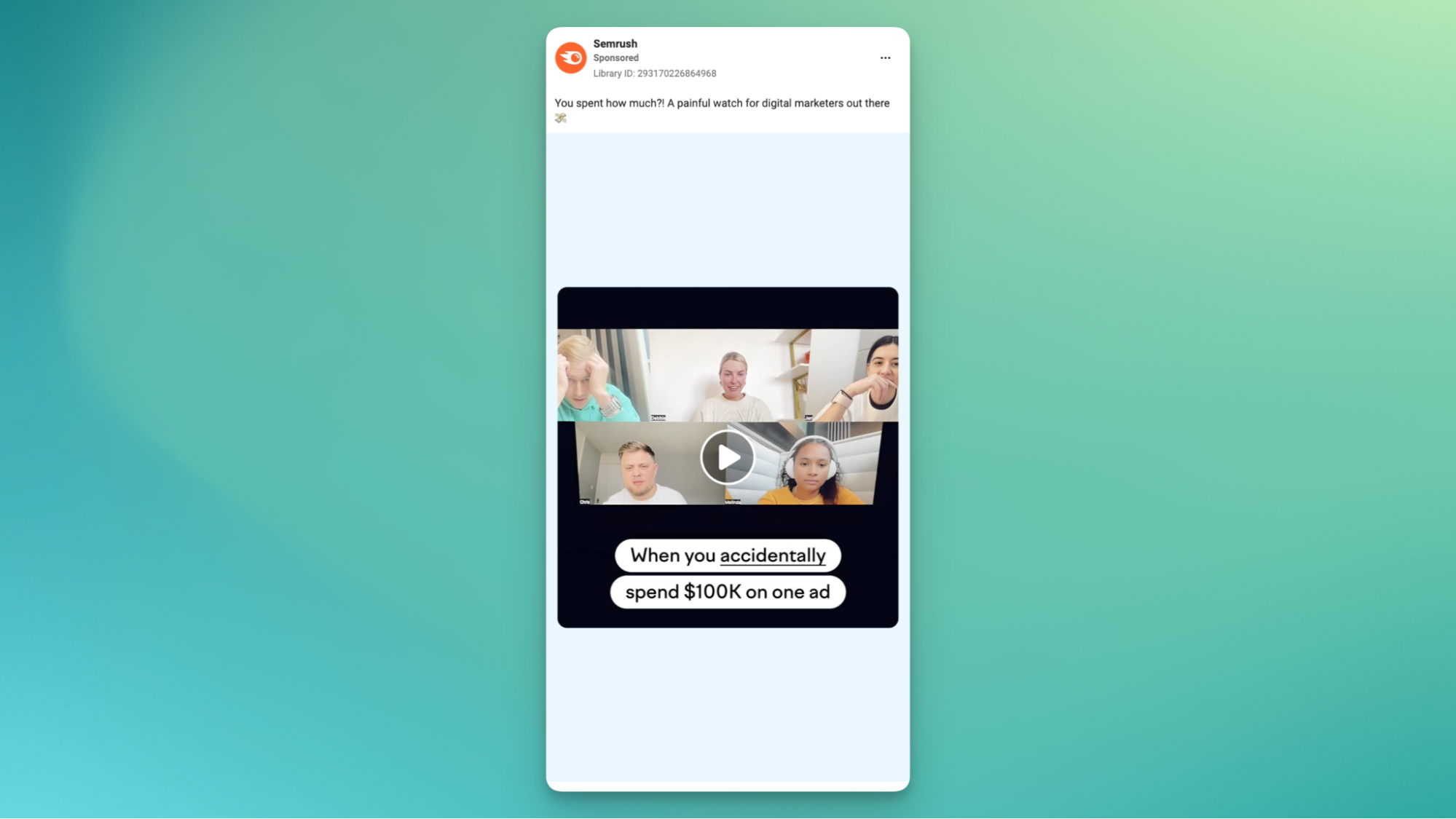
SparkToro
SparkToro, an audience insight tool for professionals, has an excellent blog where its team shares thoughts on marketing, entrepreneurship, and audience research. Rand and Amanda, the two faces of the brand, also share their updates and thoughts on social media to attract and inspire customers to try the service.

Mailchimp
Mailchimp uses social media to share interesting, helpful content for followers regularly. You can find everything from book recommendations to funny videos, hacks, and video clips from recent events.
For example, the following TikTok about abandoned cart emails netted the brand more than 300,000 views, which is big for a brand selling email software. Mailchimp’s posts are consistent and always match the brand’s look and feel, which makes its pages a good example of B2B marketing.
Descript
Descript is an all-in-one online video software that lets marketers plan, record, and edit content all in one place. As a visual tool, the brand decided to invest in growing its YouTube presence by posting how-to videos, recorded live events, and product updates. The videos help attract new leads from YouTube, but also help paid customers become better with the tool so they stick around longer.
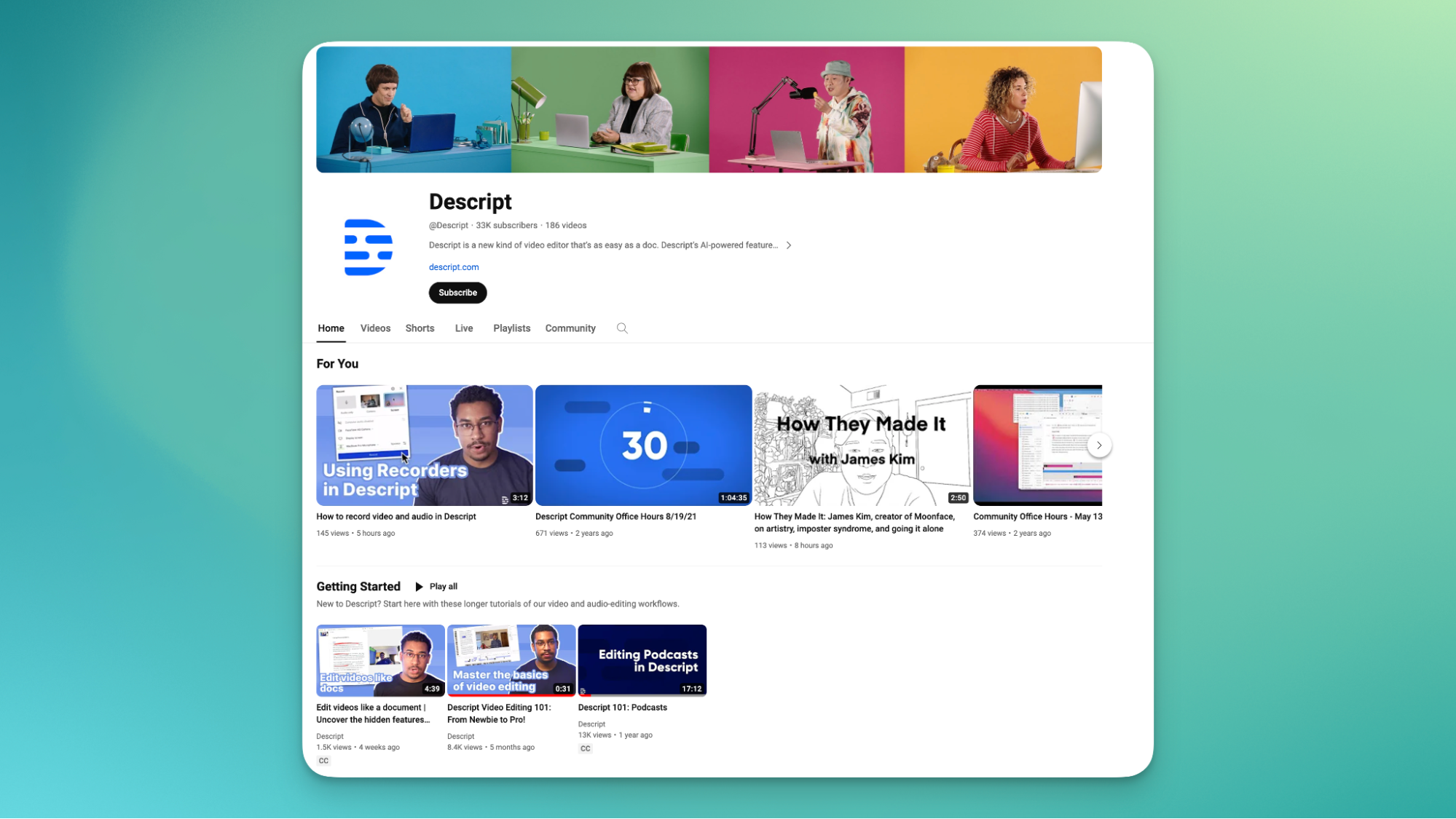
Read more
- How To Create a Successful Affiliate Program
- Beauty Marketing: How To Sell Skincare Products
- Domain SEO Explained- Choosing an SEO Friendly Domain Name
- How To Run An Instagram Giveaway- Ideas + Tips
- 8 Brand Ecommerce Blog Examples for Better Content Marketing
- TikTok for Ecommerce: How To Sell on TikTok
- 7 Best Inbound Marketing Strategies for Your Business
- Marketing Objectives- How to Set Good Marketing Objectives
- Are You Ready to Make the Most of BFCM? We’re Here To Help
- The Basics of Building an Integrated Marketing Strategy
B2B marketing FAQ
What does B2B mean in marketing?
Business-to-business marketing, or B2B marketing, is marketing products or services to other businesses or organizations.
What are the biggest challenges with B2B marketing?
B2B marketing is inherently more challenging because the products and services tend to be more complex and expensive. There are also more people involved in the decision-making process to buy B2B goods.
Some of the biggest challenges with B2B marketing include:
- Long sales cycles
- Building relationships with buyers
- Measuring ROI
- Saturated markets
- Regulatory and compliance issues
What is a B2B marketing example?
B2B marketing is when businesses market their B2B products or services to other businesses. For example, a company that sells office supplies may market to businesses that need to purchase office supplies for their employees.
What are the 4 types of B2B?
The four types of B2B are product, service, technology, and information.
What is a B2C marketing example?
B2C marketing is when a business markets its products or services to consumers. A common example of B2C marketing is when a company sells its products in a retail setting.





